Touring World Technical Writing Sites
Posted on January 13, 2015
Filed Under The Writing Life | Leave a Comment
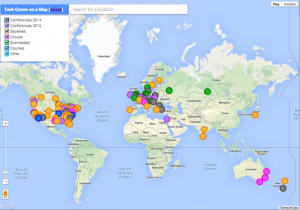 Wow! Want to know what’s going on in the world of technical writing by locale? We’ve come upon Sarah Maddox’s “Tech Comm on a Map” interactive GitHub page, Technical Communication on a Map. It’s got color-coded, click-on locations for technical communication Conferences, Societies, Groups, Businesses, Courses and, even, “Other” locations for tech com activities around the world. You can turn the categories on or off to get a clearer view of any given activity in the crowded world technical writing community.
Wow! Want to know what’s going on in the world of technical writing by locale? We’ve come upon Sarah Maddox’s “Tech Comm on a Map” interactive GitHub page, Technical Communication on a Map. It’s got color-coded, click-on locations for technical communication Conferences, Societies, Groups, Businesses, Courses and, even, “Other” locations for tech com activities around the world. You can turn the categories on or off to get a clearer view of any given activity in the crowded world technical writing community.
This is the kind of enterprising service that makes fraternity possible, whether in technical writing or any other activity. Thank you Sarah! We’re about to embark on a tour of your locales, worldwide. A great service!
Sarah does the ffeathers “technical writing and fiction” blog. Now there’s a combination!
Comments
Western Mentors Instilled Technical Writing in China
Posted on December 22, 2014
Filed Under Communication, Education, Technology, The Writing Life | Leave a Comment
Here’s a remarkable discovery on our part, illustrating anew how cooperative and interrelated our world can be if we let it. Bet you thought China somehow picked up its technical expertise on its own, enabling it to run rings around the U.S., in some respects, unassisted. Well, that’s not really so. No more than it was when W. Edwards Deming made his first trip to Japan in 1947 and started a quality transfer process there that initiated “Japan’s economic miracle”.
We’re learning from a post by Shannon Li on the Sigma Technology site that international contacts and cooperation have evidently been as important to China for technical communication as Deming-initiated quality awareness was for the Japanese. In 1997 a team of 12 technical communicators from the U.S. and Canada headed by Sam Dragga from Texas Tech University visited China and found it “hungry for technical communication education.”
“With no profession and independent academic discipline here,” Li writes from Beijing, “China was hungry for technical communication education. At that time, the English department trained translators, interpreters and tour guides for business and government organizations. Although there were courses like professional English and English for science and technology, the focus was on professional vocabularies and terms instead of on technical writing.”
So, by gosh, a group of 50 English teachers from colleges and high schools in Jiangsu Province attended lectures by the U.S./Canadian team and prepared six-day courses from them that included topics “like technical communication history, cross cultural communication in technical writing, audience, document design, types of technical writing, etc.” Between the lecturers and their Chinese students, technical writing began taking root in China.
Read more
Comments
Note-taking as a Productivity Prod
Posted on December 9, 2014
Filed Under Business, Communication, Technology, The Writing Life | Leave a Comment
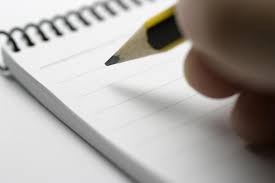 Taking notes isn’t simply scrawling a snapshot of what you’ve read so that you can recall the details later on. Technical writers, especially, should be mindful that note-taking can be a memory jog for inspiration itself – that is, it has a wider function than just “recalling”. It can be a prod for creative advances.
Taking notes isn’t simply scrawling a snapshot of what you’ve read so that you can recall the details later on. Technical writers, especially, should be mindful that note-taking can be a memory jog for inspiration itself – that is, it has a wider function than just “recalling”. It can be a prod for creative advances.
We are reminded of the creativity-prompting potential of note-taking via an edutopia post by T.R. Girill, of the Society for Technical Communication at the Lawrence Livermore National Laboratory.
There were, of course, as Girill observes, the field notes of Henry David Thoreau “on the flowering times of 500 plants near Concord, MA (that) are still used today for comparison with current climate-change data.” But, as he continues, most notes “are used by an audience of one”: yourself. Yet they can extend your reach widely.
Thus, Girill cites Eric Green’s chapter (Ch. 12) in Michael R. Canfield’s book, “Field Notes on Science and Nature” (Cambridge: Harvard University Press, 2011) in urging science students – we’d add practitioners, too – to extend the scope of their note-taking “beyond just observations or numerical data” to include such utilitarian matters as:
“• Memory aids, about places, times and conditions that could be helpful later but will be forgotten if not captured now.
“• Organizational Aids, cross references and page indexes (easiest if the notebook pages are numbered), especially for long projects.
“• Commentary – any remarks that could generate new ideas or improvements on old ideas.”
Writers and reporters have been mindful of the memory-prodding value of notes for ages. Thus the piles of notebooks and other materials that you’re apt to find in the vicinity of newspaper reporters and writers, or at least were, before the acquisition of digital data became so prominent. (We remember the table behind the desk of one reporter at the old Philadelphia Bulletin that was piled so high with notebooks and other source materials that it nearly triggered a newsroom pool as to when it might topple over.)
Girill’s post includes further prompting on memory-jogging techniques stemming from good note-taking. We’d simply restate what should by now be obvious – that the more you earnestly record, the more you’re likely to usefully recall at some especially auspicious point later on. Note-taking is well worth the time involved in jotting informative encounters amply down. – Doug Bedell
Comments
Effective Writing Isn’t Necessarily Sparse Expression
Posted on November 21, 2014
Filed Under Communication, The Writing Life | Leave a Comment
There’s a lot of interest in the subject, or style, of minimalist writing – using the fewest words possible to make a point, have impact, be clear. Google the subject, and you’ll find lots of links to a yeasty (that is extensive, rather than minimal) debate. Within limits, being sparse is admirable, so long as you communicate what you’re aiming to say. Ernest Hemingway was one of the early masters of modern minimalism, and his writing is gripping, whatever a comparative word-count with earlier writers might be.
Efficient writing? It all depends on the purpose involved.
 Good writing, actually, is a form of good manners. It’s an imposition on readers to confront them with verbosity, unnecessary words added for “show”. By now, that should be an inarguable literary principle. Good writing, though, isn’t always minimal writing – it’s appropriate writing, well-suited to the characters, purpose or setting being presented in words.
Good writing, actually, is a form of good manners. It’s an imposition on readers to confront them with verbosity, unnecessary words added for “show”. By now, that should be an inarguable literary principle. Good writing, though, isn’t always minimal writing – it’s appropriate writing, well-suited to the characters, purpose or setting being presented in words.
In the discipline of technical writing, we’d add the all-important element not merely of purpose, but specific purpose. In providing instructions to readers on how to accomplish a given procedure both efficiently and safely you want to be as clear as possible. In a technical context, clarity often means providing necessary details and cautions, while in minimalist fiction too many details or grammatical complexities might be considered an imposition on the reader.
In effective technical writing, you want to provide all the necessary details, but in as economical, that is as orderly, not necessarily as sparse, a manner, as possible.
On Google, you’ll be lead, right off, to a post by Jessica Dang on her Minimal Student blog. She is devoted to principles of minimalism in living, not only in writing. But her “Complete Guide to Minimalist Writing,” runs on a bit, presumably what happens when you are highly enthusiastic about a subject.
Writing comes down to a style appropriate to the purpose and need involved. Excessively sparse instructions – we’ve all encountered them – can be frustrating, as annoying as plot twists we’ve not been adequately prepared for. In technical writing, you’re not seeking to create a mood or resolve a crisis, but to avoid one. You’re promoting a mode of safe, economical action, and that takes a fully appropriate body of words to accomplish. – Doug Bedell
Comments
Printing Out Life’s Accessory Items – Your Very Own Shower Head!
Posted on November 12, 2014
Filed Under Technology | Leave a Comment
Running to keep up with technology? How about keeping abreast of 3D printing – you’ll need to expend a couple of extra pumps for that! The last we heard a while back, 3D printing was a curiosity with eventual marketing potential. Now, only a short while later, it seems, we find Matt Stultz on the Make website blogging about “3D Printing Around The Home: The Bathroom.” He’s spending a week focusing on 3D printing in the home, with the bathroom being his first installment.
 Yes, once you equip yourself with a 3D printer (they seem to be going for around $1,500, but that’s only after a quick look on Amazon), you can actually “manufacture” such items as shower curtain hooks, a drain snake, sink or toilet parts, or a bright red T-Rex shower head. (That certainly beats the old, chrome spray-head we’ve had there forever – it’s almost worth the price of the printer all by itself!)
Yes, once you equip yourself with a 3D printer (they seem to be going for around $1,500, but that’s only after a quick look on Amazon), you can actually “manufacture” such items as shower curtain hooks, a drain snake, sink or toilet parts, or a bright red T-Rex shower head. (That certainly beats the old, chrome spray-head we’ve had there forever – it’s almost worth the price of the printer all by itself!)
Matt is also suggesting 3D-printed items for the kitchen or workshop among, no doubt, other rooms. Before long, we’d bet, you’ll be able to print out a dwelling to accommodate them afresh!
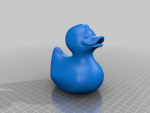 Oh, about the bathroom – we forgot to mention that, along with keeping your shower “a happy place,” in Matt’s words, you can also print out your own version of the ultimate bathtub accessory, a rubber ducky! Now, haven’t we made your day, and given you something truly worthwhile to save up for? You can thank Matt and Make for that, though.
Oh, about the bathroom – we forgot to mention that, along with keeping your shower “a happy place,” in Matt’s words, you can also print out your own version of the ultimate bathtub accessory, a rubber ducky! Now, haven’t we made your day, and given you something truly worthwhile to save up for? You can thank Matt and Make for that, though.
Now, think what you could do with a 3D printer around the office, or maybe not. – Doug Bedell
Comments
A Tech Writer’s Priority: Striving to be Clear
Posted on October 20, 2014
Filed Under Communication, Technology | Leave a Comment
When communication doesn’t work, becomes too dense or defiant, who’s at fault? Why, you’ll say, the technical writer who created the offending material. Could well be. Yet Mark Baker on a Tech Writer Today post, says the reader, as well, has a role to play in coping with printed material. But, definitely, that’s not to let the writer off the hook.
“The curse of knowledge is, of course, a real and serious matter,” Baker writes. “And a good writer is certainly one who is aware of, and able to compensate for, the curse of knowledge, at least to a degree. But the problem with blaming the failure of communication on the curse of knowledge alone is that it leads to the expectation – which (Stephen) Pinker (in a cited New Yorker essay) explicitly states – that the cure is ‘to explain the jargon, or spell out the logic, or supply the necessary detail.'”
Of course, a technical writer should be as accessible as possible to his or her readers. But the cure for dense writing, Baker argues, isn’t simply more words in the presumed interest of clarity. It’s to expect a reader to make some effort to understand what you have tried to present, provided that you, the writer, have indeed tried diligently to be clear. Due diligence becomes the key.
Baker advises technical writers that “One of the most important things to remember when providing such resources is that the reader’s goal is not to understand what you have written. A meeting of the minds is not what the reader has in mind when they crack open a technical manual. Fully understanding the contents of the writer’s mind is not what the reader is aiming for. Rather, their aim is to understand something useful about the real world.”
That calls, perhaps a bit more simply, for a technical writer to approach his or her material in the spirit of empathy, or walking in a reader’s shoes. Before tackling the material, a technical writer, like all writers, should be thinking, “Now, who will be reading this, for what purpose?” You’d think that would be self-evident for instructions to a shared workplace or the equipment therein. But not really. People, even colleagues, come to writing from all sorts of backgrounds and levels of experience.
You’ve got, first, to think clearly about “What am I trying to get across here, and what’s the most accessible way to do it?” Not simply plunge into the instructional task, even if you face some sort of deadline for completing it.
Stepping into a reader’s shoes is mandatory for any sort of successful writing, technical instructions included. With that done, instructions become guidance, and who doesn’t appreciate effective guidance? – Doug Bedell
Comments
How ‘Pushy’ Should Robots Be Allowed to Be?
Posted on October 7, 2014
Filed Under Technology | Leave a Comment
First there was concern over whether robots would replace human workers to such an extent that the economy might collapse under mass unemployment. (At least we think we remember such discussions – Google could probably help refresh us.) Now, though, robotics is an established industrial science, more robots are coming, and the question has become, according to the MIT Technology Review, “Should Industrial Robots Be Able to Hurt Their Human Coworkers?”
Hurt them, us? Picture a vengeful robot on a factory floor who thinks it got too much, or too little, oil, or programming or whatever. Should it be able to zing the engineer it deems responsible with a conk or two? Well, that’s not exactly the question. It’s more like what the U.S. Occupational Safety and Health Administration (OSHA) or the International Standards Organization (ISO) will tolerate in regulations being applied to the use of “collaborative robots” that work along with humans. Sort of like the early (or later) days of nuclear power, we imagine, and the U.S. Nuclear Regulatory Commission.
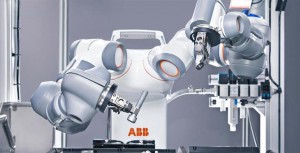 A conference was held last week on collaborative robots by the Robotics Industry Association (there was a continental breakfast and, to the best of our knowledge, no robots attended) at which it was noted that, so far, robots have been used mostly by small manufacturers where OSHA assumes they will operate only where humans aren’t nearby. (Talk about a caste system!) “We live a happy life until we reached the big companies,” says Esben Ostergaard, chief technology officer at Universal Robots, a Danish company, “– then we got all these problems about standards.”
A conference was held last week on collaborative robots by the Robotics Industry Association (there was a continental breakfast and, to the best of our knowledge, no robots attended) at which it was noted that, so far, robots have been used mostly by small manufacturers where OSHA assumes they will operate only where humans aren’t nearby. (Talk about a caste system!) “We live a happy life until we reached the big companies,” says Esben Ostergaard, chief technology officer at Universal Robots, a Danish company, “– then we got all these problems about standards.”
Comments
Notations on Note-Taking
Posted on March 14, 2014
Filed Under Uncategorized | Leave a Comment
The value of note-taking can be enhanced if your notes are taken mindfully, rather than merely routinely. That’s to say, annotating technical notes while they’re still fresh and prompting new insights can extend their reach and value.
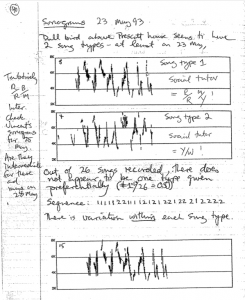 We’re glad to see T. R. Girill pick up on the value of mindful note-taking in a post on edutopia. He reminds us that Henry David Thoreau’s artfully taken field notes on the flowering times 0f 500 plants near Concord, MA, in 1851-58 “are still used today for comparison with current climate-change data.”
We’re glad to see T. R. Girill pick up on the value of mindful note-taking in a post on edutopia. He reminds us that Henry David Thoreau’s artfully taken field notes on the flowering times 0f 500 plants near Concord, MA, in 1851-58 “are still used today for comparison with current climate-change data.”
Even so, as Girill adds, though most notes are made for use by the note-taker only, they can have enhanced value by being promptly perused and expanded on virtually on-the-spot. Don’t do anything, one might add, simply to risk letting it go stale.
Girill’s reference is to Erick Greene’s chaper (Ch. 12) in Michael R. Canfield’s book on Field Notes on Science and Nature (Cambridge: Harvard University Press, 2011). Greene is a biology professor at the University of Montana, who urges science students, Girill observes, “to widen the scope of their note-taking to extend beyond just observations or numerical data” to include such enhancements as memory and organizational aids, commentary, interpretation and conjecture.
There’s no time like when the pen is “hot” to dash off such additional insights. That’s know as being truly engaged in your work. Jot down your enhancements in the margin of your page, or wherever there’s white space to profit from. – Doug Bedell
Comments
How’s Your Freezer Looking (or Sounding) Today?
Posted on March 4, 2014
Filed Under Communication, Technology | Leave a Comment
Gupreet Singh on Technical Writing ToolBox provides an interesting post on adding sounds to technical manuals. That’s right, here’s what a properly functioning home freezer should sound like – and hissing or blubbing sounds, among others, are “pictured”. Pretty creative, was our first impression.
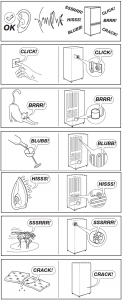 Yet the mind wanders. I thought (briefly) about how you’d go about depicting the sounds from the equipment in an operating nuclear power plant and realized, from the plants I’ve been in, that the roaring turbine generators, or steam hissing through overhead piping, just about overpowered everything else. On the other hand, though, the control rooms are quiet sanctuaries. But why distract the operators with pictures of normal background sounds they’re quite accustomed to? Documenting directions is one thing, sounds another.
Yet the mind wanders. I thought (briefly) about how you’d go about depicting the sounds from the equipment in an operating nuclear power plant and realized, from the plants I’ve been in, that the roaring turbine generators, or steam hissing through overhead piping, just about overpowered everything else. On the other hand, though, the control rooms are quiet sanctuaries. But why distract the operators with pictures of normal background sounds they’re quite accustomed to? Documenting directions is one thing, sounds another.
Maybe, indeed, illustrated sounds should be left to consumer product manuals, where the new owners are expecting to hear only a hum from their new freezers or refrigerators. And why should that be an unreasonable expectation? – Doug Bedell
Comments
Writing Is a Process, Not an Act of Creation
Posted on February 26, 2014
Filed Under Communication, Technology, The Writing Life | Leave a Comment
We’d like to make a distinction here that holds for technical writing as much as for any other kind of writing: Writing is a process, not an act. Writing and editing go together, they are part of the same process. A sentence, a paragraph or a whole page of material doesn’t just get “exhaled” from a word processor in a burst of creativity. The material will likely need to be reworked and tidied up a bit. That’s the writing process , whether in creative or technical writing.
 This important caution occurred as an “Amen,” a hearty acknowledgement, to a video clip by Ugur Akinci, PhD, at the Technical Communication Center, where “tips tutorials and trends” on technical writing and communication are offered. “The division between ‘writing’ and ‘editing’ is artificial,” Dr. Akinci said, “In real life, they are inseparable twins.” That’s inescapably true, and it’s so because, again, writing is a process, not an act of creation.
This important caution occurred as an “Amen,” a hearty acknowledgement, to a video clip by Ugur Akinci, PhD, at the Technical Communication Center, where “tips tutorials and trends” on technical writing and communication are offered. “The division between ‘writing’ and ‘editing’ is artificial,” Dr. Akinci said, “In real life, they are inseparable twins.” That’s inescapably true, and it’s so because, again, writing is a process, not an act of creation.
Good writing requires care, correction and adjustment as one goes along. It may be necessary to explain this to clients from time to time, when they wonder how you spend your time on their behalf. The human creative spirit is an amazing source of information and proficiency, so long as it’s recognized more as a meditation then a thunderbolt. Yes, you can be inspired, but even inspiration will likely require adjustment and polishing. That’s just the way we proceed to be understood clearly and well, whether we’re “creating” or rendering information proficiently. – Doug Bedell
Comments
Recently
- Presentations With Forethought
- Technical Writing’s Lineage – Surely It’s Deeper than Digital
- At the Holidays, Twitting Amazon
- Successful Cookie Baking – From Mom, an Acknowledged Expert
- Slides for a Tech Writer’s Craft
- Digital or Not, Be Clear
- Being Watchful About Digital Designs…
- When Proposals Don’t Click, Keep Making Them Anyway
- Like a Good Gardener, Help an Enterprise Keep Itself Current
- We’re Leaders All, And Need to Think That Way
Categories
Archives
- January 2017
- December 2016
- November 2016
- October 2016
- September 2016
- August 2016
- July 2016
- June 2016
- May 2016
- April 2016
- March 2016
- February 2016
- January 2016
- December 2015
- November 2015
- October 2015
- September 2015
- August 2015
- July 2015
- June 2015
- May 2015
- April 2015
- March 2015
- February 2015
- January 2015
- December 2014
- November 2014
- October 2014
- March 2014
- February 2014
- January 2014
- December 2013
- November 2013
- October 2013
- September 2013
- August 2013
- July 2013
- June 2013
- May 2013
- April 2013
- March 2013
- February 2013
- January 2013
- December 2012
- November 2012
- October 2012
- September 2012
- August 2012
- July 2012
- June 2012
- May 2012
- April 2012
- March 2012
- February 2012
- January 2012
- December 2011
- November 2011
- October 2011
- September 2011
- August 2011
- July 2011
- June 2011
- May 2011
- April 2011
- March 2011
- February 2011
- January 2011
- December 2010
- November 2010
- October 2010
- September 2010
- August 2010
- July 2010
- June 2010
- May 2010
- April 2010
- March 2010
- February 2010
- January 2010
Blogroll

